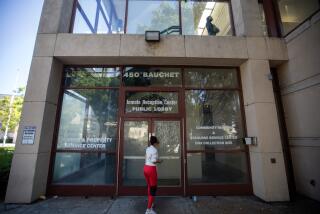Probe of Hospice Nurse in Patient Deaths Stalled
- Share via
SAN BERNARDINO — The police investigation into charges that a hospice nurse injected 17 of her terminally ill patients with lethal amounts of morphine is on hold for about two weeks, pending the results and evaluation of a “very difficult” toxicology examination on one of the bodies, authorities said Wednesday.
The San Bernardino County coroner’s office said the evaluation will help investigators decide whether to exhume additional bodies and whether to continue the probe or drop it for lack of evidence.
Until then, police say, there is little more to do.
“We’re in a holding pattern until we have an indication of something to look at,” said Police Lt. Dan Wylde of Rialto, where two of the patients lived. “Until then, it’s just an allegation. We want to rely on the expertise of the coroner’s office and toxicology report to lend credence to the allegation.”
San Bernardino Police Department spokesman Jim Hamlin said investigators there are “at a standstill. . . . We’ve turned it over to the coroner.”
San Bernardino County Coroner Brian McCormick said at a news conference Wednesday that the investigation will be very difficult because his staff will have to determine not only how much morphine was in the exhumed body, but also whether the dose was high enough to kill, based on such variables as the patient’s condition and how long he had been given the drug.
“We’re going to be breaking new ground in the evaluation of morphine toxicity,” McCormick said.
Morphine is typically administered under doctor’s orders to reduce the pain afflicting terminally ill patients, but at least one co-worker of hospice nurse Darlene Leon alleged to police--and said later on a television news report--that Leon administered overdoses of morphine to patients under her care.
Co-workers reportedly nicknamed Leon the Angel of Death, but Leon told KNBC Channel 4 news that the moniker simply referred to her work with the terminally ill.
Leon no longer works for the home nursing registry that provided the hospice care and could not be reached for comment. David Call, the attorney for the Claremont-based Visiting Nurses Assn. of Pomona-San Bernardino, said the company is cooperating fully with investigators.
“People’s reputations and careers and businesses are on the line,” he said. “Everybody on my side will take lie detector tests and psychiatric examinations, if they’d just ask the whistle-blowers to do the same.”
McCormick refused Wednesday to identify Leon as the target of a multi-agency law enforcement task force he is heading to investigate the charges, but he said the common denominator in each of the deaths was the “proximity” of the same nurse.
While hospice nurses, by definition, are trained to ease the death of terminally ill patients, what pricked the concern of police investigators was the timing of the deaths, McCormick said.
“If a health care provider is providing appropriate care, with documentation and following a physician’s orders, I don’t think there’s any reason to be suspicious of a death, particularly in a hospice situation,” McCormick said. “They’re expected to die. But maybe not as suddenly as some of these individuals.”
In these cases, McCormick said, some of the patients died sooner than their families had expected. That, and the association of the same nurse, served as a “red flag” for police, he said.
None of the families of the patients had questioned the deaths, he added.
On Monday, his office exhumed the body of Homer Schreiber, a cancer victim who died at 94 in December and was buried in Redlands.
The investigation includes a review of Schreiber’s medical records and may include interviewing the health care provider involved in his care, McCormick said.
If the toxicology findings on Schreiber are suspicious, McCormick said, other bodies may be exhumed. In that case, he said, his financially strapped office would need to ask for funding from the San Bernardino County Board of Supervisors.
“This would be new ground for us, to be able to contribute to the overall safety of our senior citizens, people who are least able to protect themselves,” he said. “We’re dealing with some very vulnerable individuals.”
More to Read
Sign up for Essential California
The most important California stories and recommendations in your inbox every morning.
You may occasionally receive promotional content from the Los Angeles Times.













